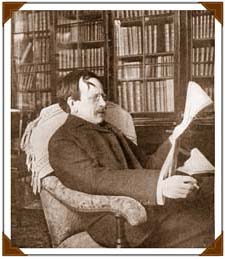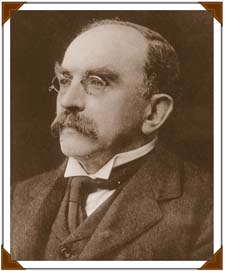
J.J. Thomson at
home in his
study in 1899.
|
"At first there were very few who believed in the existence of these bodies smaller than atoms."
|
|
 homson presented three hypotheses about cathode rays based on his 1897 experiments: homson presented three hypotheses about cathode rays based on his 1897 experiments:
- Cathode rays are charged particles (which he called "corpuscles").
- These corpuscles are constituents of the atom.
- These corpuscles are the only constituents of the atom.
 HEAR J.J. THOMSON talk about the size of the electron. HEAR J.J. THOMSON talk about the size of the electron.
 homson's speculations met with some skepticism. The second and third hypotheses were especially controversial (the third hypothesis indeed turned out to be false). Years later he recalled, "At first there were very few who believed in the existence of these bodies smaller than atoms. I was even told long afterwards by a distinguished physicist who had been present at my lecture at the Royal Institution that he thought I had been 'pulling their legs.'" homson's speculations met with some skepticism. The second and third hypotheses were especially controversial (the third hypothesis indeed turned out to be false). Years later he recalled, "At first there were very few who believed in the existence of these bodies smaller than atoms. I was even told long afterwards by a distinguished physicist who had been present at my lecture at the Royal Institution that he thought I had been 'pulling their legs.'"
|
|

Joseph Larmor
|
 he word "electron," coined by G. Johnstone Stoney in 1891, had been used to denote the unit of charge found in experiments
that passed electric current through chemicals. In this sense
the term was used by Joseph Larmor, J.J. Thomson's Cambridge
classmate. Larmor devised a theory of the electron that
described it as a structure in the ether (the invisible elastic
fluid that was proposed as a substrate for light and other
electrical phenomena). But Larmor's theory did not describe the
electron as a part of the atom. When the Irish physicist George
Francis FitzGerald suggested in 1897 that Thomson's corpuscles
were really "free electrons," he was actually disagreeing
with Thomson's hypotheses. FitzGerald had in mind the kind of
"electron" described by Larmor's theory. he word "electron," coined by G. Johnstone Stoney in 1891, had been used to denote the unit of charge found in experiments
that passed electric current through chemicals. In this sense
the term was used by Joseph Larmor, J.J. Thomson's Cambridge
classmate. Larmor devised a theory of the electron that
described it as a structure in the ether (the invisible elastic
fluid that was proposed as a substrate for light and other
electrical phenomena). But Larmor's theory did not describe the
electron as a part of the atom. When the Irish physicist George
Francis FitzGerald suggested in 1897 that Thomson's corpuscles
were really "free electrons," he was actually disagreeing
with Thomson's hypotheses. FitzGerald had in mind the kind of
"electron" described by Larmor's theory.
 radually scientists accepted Thomson's first and second hypotheses, although with some subtle changes in their meaning. Experiments by Thomson, Lenard, and others through the crucial year of 1897 were not enough to settle the uncertainties. Real understanding required many more experiments over later
years. radually scientists accepted Thomson's first and second hypotheses, although with some subtle changes in their meaning. Experiments by Thomson, Lenard, and others through the crucial year of 1897 were not enough to settle the uncertainties. Real understanding required many more experiments over later
years.
|

Ernest Rutherford
|
 heories about the atom proliferated in the wake of Thomson's 1897 work. If Thomson had found the single building block of all atoms, how could atoms be built up out of these corpuscles? Thomson proposed a model, sometimes called the "plum pudding" or "raisin cake" model, in which thousands of tiny, negatively charged corpuscles swarm inside a sort of cloud of massless positive charge. This theory was struck down by Thomson's own former student, Ernest Rutherford. Using a
different kind of particle beam, Rutherford found evidence that
the atom has a small core, a nucleus. Rutherford suggested that
the atom might resemble a tiny solar system, with a massive,
positively charged center circled by only a few electrons.
Later this nucleus was found to be built of new kinds of
particles (protons and neutrons), much heavier than
electrons. heories about the atom proliferated in the wake of Thomson's 1897 work. If Thomson had found the single building block of all atoms, how could atoms be built up out of these corpuscles? Thomson proposed a model, sometimes called the "plum pudding" or "raisin cake" model, in which thousands of tiny, negatively charged corpuscles swarm inside a sort of cloud of massless positive charge. This theory was struck down by Thomson's own former student, Ernest Rutherford. Using a
different kind of particle beam, Rutherford found evidence that
the atom has a small core, a nucleus. Rutherford suggested that
the atom might resemble a tiny solar system, with a massive,
positively charged center circled by only a few electrons.
Later this nucleus was found to be built of new kinds of
particles (protons and neutrons), much heavier than
electrons.
|
|
|
Table of Contents:
Exhibit Home
J.J. Thomson
Mysterious Rays
1897 Experiments
Corpuscles to Electrons 
Legacy for Today
More Info
|
 Legacy for Today Legacy for Today
|



